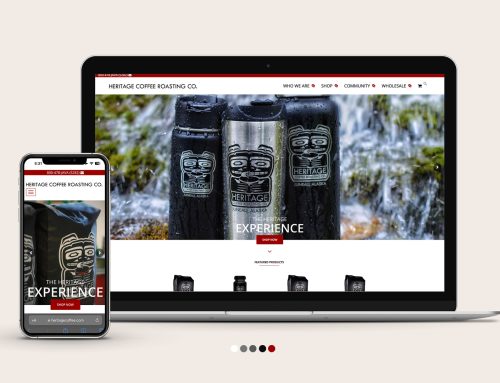Cutting-Edge Brand Design Trends for 2025 Revealed

BusinessDasher reports that 80% of frequent shoppers prefer brands that personalize their shopping experience. This shows that customers are expecting more than just products – they want meaningful connections.
As a business owner, it’s crucial to keep up with the latest branding trends to stay competitive. In 2025, brand design is no longer about aesthetics; it’s about innovation, personalization, and fostering authentic relationships.
From AI-driven branding to interactive experiences, businesses must adapt to emerging trends that redefine how they engage customers. If you want your business to stand out, you need to embrace the latest designs that capture attention and build lasting connections.
Explore the key emerging design trends shaping 2025 and how to leverage them to future-proof your business.
Minimalism with a Bold Twist
Minimalism has been dominant for years, but in 2025, it’s taking a bolder and more refined form. Gone are the days of overly simplistic designs that can be easily overlooked. Instead, brands are opting for vibrant, eye-catching visuals that make a statement.
Some of the elements of this new emerging design trend include:
Oversized Topography
This trend involves using large, bold fonts that dominate the design and capture attention. Oversized topography shifts focus from the intricate design details to the message itself. This ensures that the message is the first thing your client notices.
If your goal is to make a powerful statement and keep the focus on what matters, oversized topography is an excellent choice. Whether for headlines, slogans, or product names, this technique gets the message across with clarity and emphasis.
Dynamic Color Palettes
Instead of relying on muted or monochrome tones, you can inject vibrancy into your design with dynamic color palettes. This approach embraces the use of bold and contrasting colors to evoke emotions and draw attention.
Combining unexpected color pairings makes your brand stand out in a saturated market. It can also create a visual identity that feels fresh and modern. If you feel that your design is blending into the background, break free with dynamic color palettes.
Striking Shapes
Geometric and abstract shapes play a larger role in minimalist design. They help break up the simplicity of a design by adding structure and visual interest without overwhelming the viewer. These shapes also introduce an element of creativity and innovation, giving brands a modern edge.
If you want your brand to feel both sleek and dynamic, consider incorporating these bold design elements. They can be the game-changers that set your design apart.
AI-Driven Design and Personalization
AI is revolutionizing brand design by offering highly personalized and data-driven experiences. More businesses are harnessing its power to create tailored experiences for their customers. They are using AI to:
- Analyze vast amounts of consumer data
- Predict customer preferences and behaviors
- Deliver personalized product recommendations
- Automate the creation of dynamic website layouts
- Optimize market campaigns
Additionally, AI can automate repetitive design tasks, enabling your team to concentrate on more strategic priorities. As a result, teams leveraging AI register higher performance and productivity levels. If you are considering adopting AI in your brand, here are some steps and processes to ensure its success:
Select the Right AI tools
Start by selecting AI design tools that align with your business’s needs. Choose tools that complement your goals and integrate seamlessly with your existing systems. Also, ensure that these tools are scalable so they can grow with your business and adapt to future requirements.
Don’t forget about costs. Check and compare the pricing of various AI tools to help you budget appropriately.
Collect Quality Data
AI thrives on quality data. Ensure you collect data across various touchpoints, including your website, social media, and purchase history. Organize and segment this data based on customer behaviors, preferences, and demographics.
By doing this, you can make informed decisions when tailoring customer’s shopping experience. It also helps you create visuals that resonate with your audience.
Monitor and Optimize Campaigns
After deploying AI tools, continuously measure their performance. You can utilize A/B testing to compare different AI design elements.
If they are not performing as expected, adjust them based on customer feedback or behavioral data. This iterative approach ensures your AI strategy remains effective and relevant. When well integrated, AI can refine your brand design, ensuring it evolves with market trends.
Immersive & Interactive Branding
As technology continues to evolve, brands are embracing new ways to engage customers through interactive experiences. Augmented Reality (AR) and Virtual Reality (VR) are at the forefront of this trend. These technologies offer customers the chance to interact with your brand in unique and engaging ways.
With AR, customers can visualize products in a real-world setting before making their purchase. For instance, if you are selling clothes, customers can try them on with AR to see how they fit them. If it’s furniture, they can see how it fits in their space and what the layout will look like.
VR, on the other hand, transports customers into fully immersive environments, allowing them to experience your brand’s story firsthand. This can include:
- Virtual store walkthroughs
- Behind-the-scenes brand experiences
- Interactive storytelling
Such experiences create a deeper emotional connection with your audience. As a result, your brand will become more engaging and memorable.
Incorporate AR and VR into your business to connect the digital and physical shopping experiences. By assessing products in a realistic setting before committing to a purchase, customers will feel confident in their purchasing decisions. This can also reduce the return rate, ultimately strengthening brand loyalty.
Sustainable and Ethical Branding
Sustainability isn’t just a trend – it’s an expectation in 2025. Consumers want to support brands that genuinely care about the planet. If your business isn’t making efforts to conserve the environment, you risk losing customer’s trust.
It’s no longer enough to say you’re eco-friendly; you need to show it. Be transparent about where your materials come from and whether you use recyclable packaging. Focus on meaningful initiatives like reducing carbon footprint and switching to sustainable production methods.
When you prioritize sustainability, you’ll not only help the environment but also build stronger relationships with your customers. If you haven’t already started, now is the time to act. Look at your brand’s operations and identify areas where sustainable changes can be made.
Partner with ethical suppliers who share your sustainability values. Most importantly, ensure you involve your customers in the journey. Share progress, successes, and even challenges with them. This transparency will encourage them to support you.
Dynamic & Adaptive Logos
In this digital era, static logos are becoming a thing of the past. Brands are increasingly opting for dynamic and adaptive logos that change based on the platform or user interaction.
These logos can adjust to different screen sizes and even cultural contexts. This ensures that they always look fresh.
With dynamic logos, you get the flexibility to maintain your brand’s identity while responding to different environments. Imagine your logo animating according to the time of day or adapting to major events. This kind of creativity can make your brand feel more personal and engaging.
Brands like Google have already embraced this concept. Their logos adjust and evolve across different platforms, adding fun and relevance. So, don’t get left behind – make your logo dynamic and flexible to stay ahead of the curve.
Retro-Futurism and Nostalgic Aesthetics
In 2025, retro-futurism is making a big splash. It combines visuals from the past with futuristic elements, creating a cool mix of old and new. Think back to design styles from the 80s, 90s, and even early 2000s, but with a modern twist.
The result? A sense of comfort and familiarity that feels fresh and forward-thinking. This nostalgic branding can evoke memories and tap into emotions. As a result, customers will feel more attached to your brand.
But it’s not just about copying old styles. It’s about taking those retro vibes and updating them in a way that feels innovative. Think about how your audience connects with past trends and refresh those elements to resonate with today’s world.
Lead With Authenticity
Authenticity isn’t a fad. It’s the foundation of modern branding techniques. An authentic brand seamlessly merges identity and functionality, striking a balance between who you are and what your business stands for.
Whatever you promise to your customers, make sure to deliver on it consistently. When your brand feels real and true to itself, it builds trust and connection with customers. Therefore, when creating your mission and values, ensure they reflect your true beliefs and actions.
Don’t buy fake positive reviews to attract customers. They can erode the trust of your loyal customers.
Always handle every customer feedback with positivity and care. This shows new online visitors that you’re friendly and are willing to address their concerns.
Community-Centric Strategies
In 2025, brands aren’t just selling products alone. They are creating spaces where customers feel like they truly belong. Whether online or in person, these spaces encourage connection, collaboration, and co-creation.
They make the customers feel as if they are part of something bigger. If your business hasn’t embraced this change yet, now is the time to start. Create digital and physical spaces that foster genuine community engagement.
Here is a breakdown of what the two spaces entail:
Digital Spaces
Some of the online communities you can tap into include:
- Private and social group platforms like Slack, discord, and Facebook
- Hosting virtual events and webinars
- Co-creation and crowdsourcing
For instance, crowdsourcing allows you to involve customers in the creative process, from product development to marketing campaigns. This ensures that the products you create and the marketing strategies you use resonate deeply with your customers.
Physical Spaces
While digital spaces are powerful, face-to-face interactions still hold immense value. To enhance one-on-one interaction with your customers, consider the following:
- Setting up pop-up experiences and brand activations
- Transforming retail spaces into community hubs
- Hosting in-person events and meetups
By embracing both digital and physical spaces, you won’t just be selling products. You will be building a community and fostering a sense of belonging. Over time, this can deepen customer loyalty, turning them into true advocates for your brand.
Voice Activated Branding
Voice technology is transforming how customers interact with brands. With voice assistants like Siri and Alexa becoming a part of life, more and more customers are embracing voice search. If your business isn’t optimized yet, you might be missing out on the future of brand design.
Voice-activated branding makes it easier for customers to find products, ask questions, and even make purchases. It also makes the engagement faster and more intuitive. To leverage this technology, consider:
- Optimizing your website for voice search
- Integrating voice assistants
- Creating a unique brand voice
- Offering a voice-activated shopping experience
By implementing these strategies, you’ll offer your customers a seamless, user-friendly experience. This not only enhances convenience but also positions your brand as forward-thinking and accessible.
Imagery Matters: Embrace Inclusivity
In a diverse country like ours, representing inclusivity isn’t just a trend; it’s a necessity. Brands are shifting away from stereotypes and embracing diversity in a way that truly reflects the real world. Whether it’s through race, gender, or age, showcasing visuals that connect with a wide range of identities will help your business stand out.
In 2025, customers want to see themselves in your brand. You can achieve this by:
- Featuring people from different backgrounds, races, and genders in your products
- Embracing different body types, fashion choices, and lifestyle preferences
- Avoiding outdated or harmful stereotypes
By embracing inclusive imagery, you’re not just checking a box. You’re building a brand that genuinely values diversity, fostering deeper connections with your audience.
Create a Unique Path for Your Brand Design in 2025
In 2025, success lies in crafting a brand design that truly resonates with your audience. By embracing the latest trends and making bold choices, you differentiate your brand from the competition.
At Clear Mind Graphics, we create compelling brand designs that capture attention and connect with your audience. Led by our experienced team, including Sarah Murphy and Laurie Christian, we specialize in logos, websites, and cohesive brand identities. Serving the Wood River Valley, western U.S., and Alaska, let’s work together to shape your unique brand journey.
Get in touch today and bring your vision to life.




